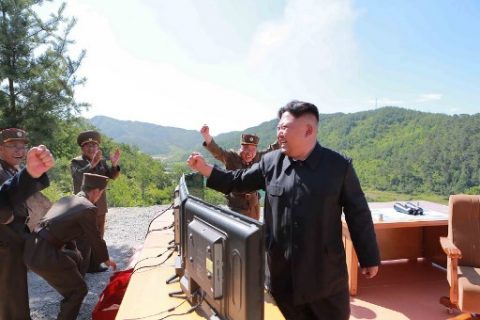

by Max Delany with Sebastien Berger in Seoul
Agence France Presse
MOSCOW, Russia (AFP) — North Korea’s declaration of a successful first intercontinental ballistic missile test on Tuesday triggered a joint appeal from China and Russia for a military freeze to try and lower soaring tensions between Pyongyang and the United States.
The launch came as Americans prepared to mark Independence Day and it sparked a Twitter outburst from President Donald Trump who urged China to act to “end this nonsense once and for all.”
The North’s possession of a working ICBM — something Trump had vowed “won’t happen” — represents a milestone for the communist regime.
It could also radically alter the calculus for countries seeking to thwart the military goals of the isolated state.
Some experts said the device could reach Alaska. Others suggested it could go much further toward the US mainland though there was widespread scepticism of the North’s claim of the missile being able to “strike any place in the world.”
The Hwasong-14 missile test was overseen by Kim Jong-Un, an emotional female announcer said on state television, showing a handwritten order for the launch and pictures of the young leader grinning in celebration, clenching his fist.
The North’s Academy of Defense Science, which developed the missile, said it reached an altitude of 2,802 kilometers and flew 933 kilometers, calling it the “final gate to rounding off the state nuclear force.”
G20 meet planned
China and Russia called for a moratorium on further missile and nuclear tests by Pyongyang after a meeting between leaders Vladimir Putin and Xi Jinping in Moscow.
They also called for a simultaneous suspension of large-scale US-South Korea military exercises.
“The opposing sides should start negotiations and affirm general principles of their relations including the non-use of force, rejection of aggression and peaceful coexistence,” the joint statement said.
Trump has been pinning his hopes on China — North Korea’s main diplomatic ally — to solve the crisis, but troubles have escalated since the US leader took office in January.
There are still doubts whether the North can miniaturize a nuclear weapon to fit a missile nose cone, or if it has mastered the technology needed for it to survive re-entry into the Earth’s atmosphere.
But since Kim came to power there have been advances including three nuclear tests and multiple rocket launches.
In response to the launch but before the announcement, Trump asked on Twitter: “Does this guy have anything better to do with his life?”
The United Nations has imposed multiple sets of sanctions on Pyongyang, which claims that it needs nuclear arms to defend itself against the threat of invasion.
The European Union said Tuesday that it may consider further sanctions against the North, having last month expanded a blacklist.
‘The threat has grown ‘
US Pacific Command confirmed the test and said it was a land-based, intermediate range missile that flew for 37 minutes before splashing down in the Sea of Japan, adding the launch did not pose a threat to North America.
Moscow’s defense ministry called it medium-range. But Tokyo — in whose exclusive economic zone it came down — estimated the maximum altitude to have “greatly exceeded” 2,500 kilometers, prompting arms control specialist Jeffrey Lewis to respond on Twitter: “That’s it. It’s an ICBM. An ICBM that can hit Anchorage not San Francisco, but still.”
David Wright, of the Union of Concerned Scientists, wrote on the organisation’s allthingsnuclear blog that the available figures implied the missile had “a maximum range of roughly 6,700 (kilometers) on a standard trajectory.”
“That range would not be enough to reach the lower 48 states or the large islands of Hawaii, but would allow it to reach all of Alaska.”
Antoine Bondaz, an analyst at the Foundation for Strategic Research in Paris, said the launch was a “humiliation” for Trump after his repeated attempts to get China to rein in Pyongyang, adding that greater missile ranges were probably possible in future tests.
“If you change the initial angle of fire, you could reach a range of 6,700 (kilometers). Ballistics is like throwing a rock: the farther you want to go, the lower the angle of fire,” Bondaz added.
Japanese Prime Minister Shinzo Abe told reporters: “This launch clearly shows that the threat has grown.”
The US, Japan and South Korea will hold a summit on the sidelines of this week’s G20 meeting, he added. “Also I will encourage President Xi Jinping and President Putin to take more constructive measures.”
South Korea’s President Moon Jae-In warned the North against crossing “the bridge of no return.”
Washington, South Korea’s security guarantor, has more than 28,000 troops in the country. Fears of conflict peaked earlier this year as Trump’s administration suggested military action was an option.
There has also been anger in the US over the death of Otto Warmbier, an American student detained in North Korea for around 18 months before he was returned home in a coma in June.
© Agence France-Presse
